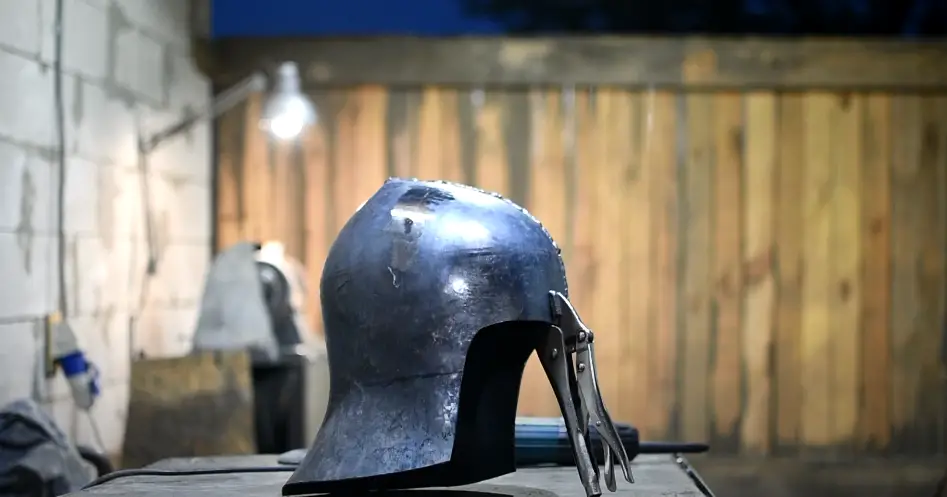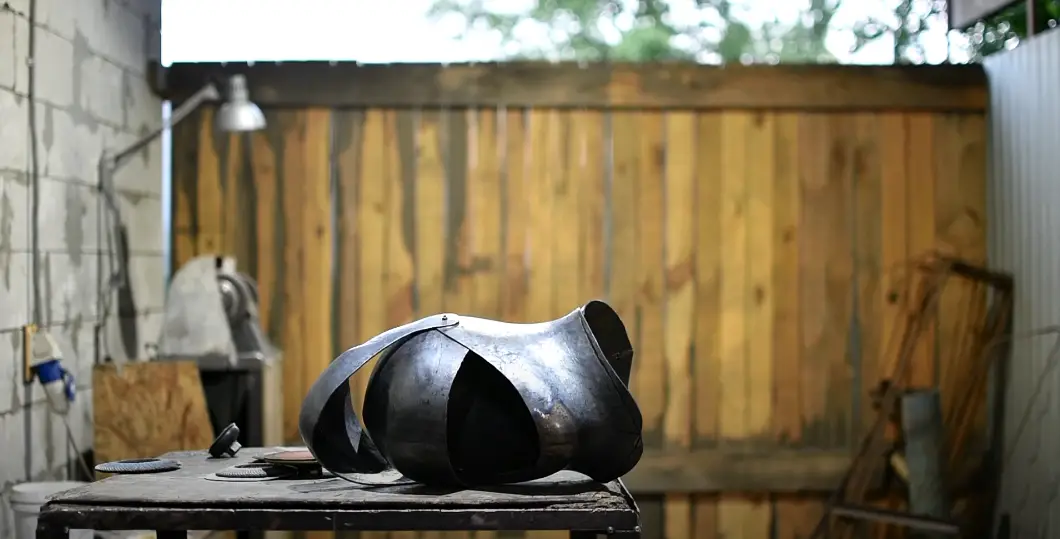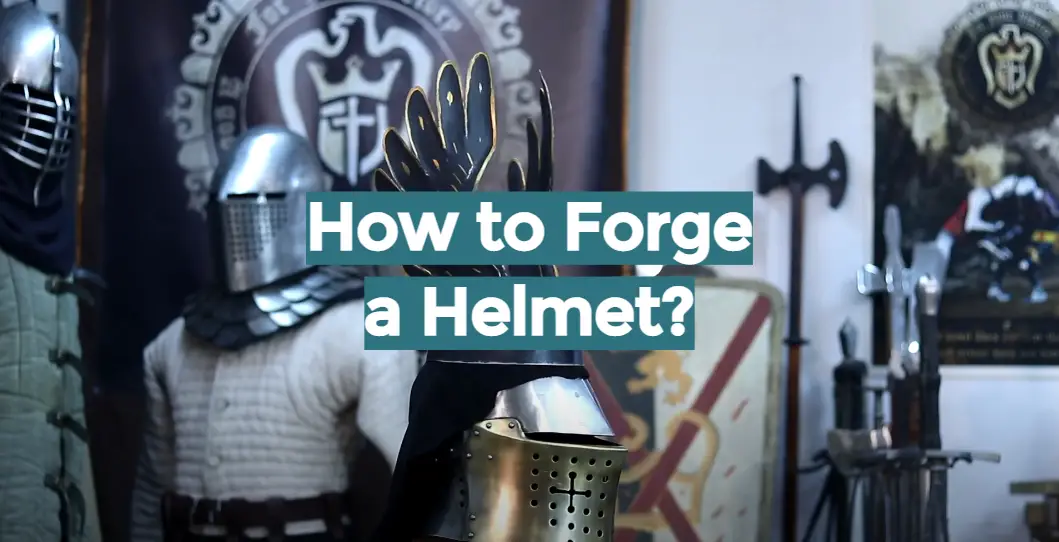One of the oldest blacksmithing designs is a helmet. During battles, safety helmets are an essential piece of equipment. As a consequence, although blacksmiths forge blades and other weapons for knights, they often forge protective clothing. Before explaining how to forge a helmet, there are a few things to clarify.
Table of Contents
The “outside” and “inside” methods of helmet forging
“Outside” forging
This technique is used to make drawn helmets that are smooth (e.g. sallet/bascinet made of one piece, without any welding). Insert the beakiron with the mandrel into the anvil, then position the billet on the mandrel, hold it in the air, then hammer on the top edge of the mandrel to form the billet into the shape. This process takes a long time and necessitates at least simple forging skills.
“Inside” forging
A wooden stub with a tiny hole and a hammer with a circular pain might be needed for such forging. A strong wood hammer or a metal hammer may be used. The harder stub is, the quicker it is to work with.
Cold and hot forging techniques
The forging technique implies the use of cold or hot billets. Try to tell yourself that it is not impossible and that you can excel.
Hot forging
It’s a way of dealing with a metal that requires heating it first. Metal becomes brittle and malleable as a result of heating. There are several papers about how to control the metal heating mechanism, such as utilizing a thermometer or adjusting the color. When the hot metal turns a yellowish red color, it’s at the right temperature.
Some spring steels that can be hardened can’t be heated multiple times, but forming them should be achieved all at once, without causing the metal to cool, and at the optimum temperature.
Cold forging
Most experts suggest beginning with this tech because it is secure, simple to understand, and needs less equipment. Its key argument is straightforward: the metal is forged without fire, with many slack strikes, gradually forming the ideal shape.
How to forge a helmet: the most straightforward method
The procedures for forging a helmet are straightforward. They are, though, a little technical. Therefore, it’s important to pay attention to the finer points. Here’s a useful yet simple reference to make the method of forging a helmet go more smoothly.

Here is what you need to forge a helmet:
- Chisel;
- Shallow dish;
- Jigsaw;
- Scissors;
- A few hammers for dishing, planishing and a cross-pen type;
- Anvil;
- Drill;
- Torch;
- Ball stake;
- Side cutters;
- Bolts and nuts;
- Nails;
- Pliers;
- Bench grinder;
Assemble the materials and tools
To begin, keep in mind that the method of forging a helmet differs slightly from other blacksmithing methods. You’ll need accurate calculations on any of the products you’ll be using. This measurement, however, will be affected by the chosen template.
Creating a design for your helmet
Consider the nature of the helmet you’d like to create. You should be conscious that there are various styles of metallic masks available. You may even build your schedule.
For a proper guide, you should draw the template on a sheet of paper. You can avoid complex patterns if you don’t have enough blacksmithing experience. Particular attention should be paid to the positioning of the nasal and eye spaces.
You will draft the calculation from the concept sketch. Make sure each section of the helmet is the right size. You should proceed until you’ve determined the dimensions of each object.
Cutting followed by cleaning
It’s now time to make a separate piece of the helmet. This move is critical to the project’s success. It’s the trickiest aspect of the procedure:
- For a pencil or other that can create a mark, draw the template onto your steel;
- Using a jigsaw, begin cutting out the individual components that you have marked out;
- Make sure the cut is straight and so you may bevel the ends;
- If there is a sharp component, consider blurring it;
- Draw a line on the scrap paper for guidance, which will act as a template for the rest of the process;
Bear in mind that everyone’s head is distinctive in size and form. Now you should apply the template to the head and trim away any excess material. You can trim it so that there is enough room for the helmet lining. If you’re only making a helmet for looks, a margin between 1.5 to 2.3 inches across the head diameter would suffice. If you’re making a war helmet, the margin should be no less than 4 inches across. For the fight, you’ll need a thicker lining, as well as room for the helmet to crash.
Building the frame
This step is critical because your helmet’s skeletal construction would be built around this frame:
- Determine how all of the required components should be organized;
- Send the sections that require to be curled curves. Make sure you’re using accurate measurements for this. The procedure varies greatly depending on the sort of helmet you choose to create;
- You will begin temporary assembly until all of the individual pieces are in order. The aim of this arranging is to make sure that each component suits properly;
- If any changes are needed, make them;
- To render required curves, apply a hammer and other appropriate materials;
Finalizing the planishing
It’s now time to work for better patterning. It’s also a good idea to do riveting and then planishing. A planishing hammer is needed for planishing. Planishing (comes from the Latin word “planus” – it means “flat”) is a metalworking procedure that includes finely forming and smoothing sheet metal to finish the surface.
Reassemble the modules until you’ve done with this step.
Fixing the panels
You can now be finished with the helmet’s framework. It’s time to put the finishing touches on the template by adjusting the layouts. Adding the panels is a simple procedure if the framing is done correctly.
You may want to try marking the panel’s side to let you distinguish between the inside and outside. Whether the panels don’t match well, don’t be concerned. If you have your cutting right, a small change can help you fix them.
Assemble all the parts
It’s time to start focusing on the general shape of the helmet. Gather the panels on the mask’s framework. You can want to drill a rivet hole in the helmet to assist in the proper joining of the pieces.
Depending on the sort of helmet you choose to create, the process of entering the helmet is different. You have to pick the most fitting form. Welding, forging, or bolting are both choices for joining it together.
The finishing stage
This finishing is determined by the previous stage. You won’t require any extra finishing if you use the bolting process. Only make sure your helmet is in good condition, and you may want to try polishing it.

Forging and welding can necessitate a more detailed finish. Remove any unnecessary weld. Overall, make sure the final touches polish the job to make it look more attractive.
Tips for DIYers who forge a helmet
- Start hammering on the billet by putting it on a flat stub. The hammer should strike the spot on the stub where the hole is;
- It is not essential to beat the billet’s center point; instead, it is recommended to hit spirally from the inside edge. Normally, the spiral would have 7-8 circles from the first blow from the rim to the middle point of your billet;
- Primary forging (metal drawing) must be distinguished from straightening (the proper metal alignment);
- Do not pound too hard. If you’re using hot welding, it’s good if the metal is drawn to a depth of 3-5 mm after each stroke. No one doubts that you can hit the metal so hard that the hammer can pierce it, but if you’re making a combat helmet, the metal must drive its thickness and weight;
- Take your time. Based on the qualifications and skills, 8-20 hours of unhurried, deliberate hammering would suffice. There’s no reason to rush; rushing results in torn billets or metal that are too brittle to withstand crushing;
FAQ
Is it possible to forge a helmet that may withstand a sword?
The aim of wearing a helmet is to keep the consumer safe. If you correctly forge a helmet, it should be capable of providing protection.
Is it possible to forge a helmet with real Damascus steel?
Yes, really. Damascus steel may be used to forge a helmet. If you don’t have sufficient blacksmithing skills, though, it’s not a good idea.
How much does it cost to forge a helmet?
It is not expensive to forge a helmet. If you’re a working blacksmith, you’re likely to have most, if not any, of the resources you’ll need. The things you’ll have to spend money on are forge fuel and stock metal for the forging operation.
What are some tips for forging helmets?
There are a few key things to keep in mind when forging helmets:
- Pay attention to the thickness of the metal. The thicker the metal, the more durable the helmet will be.
- Make sure the helmet is properly shaped. A well-shaped helmet will offer better protection than one that is poorly shaped.
- Be sure to smooth out any sharp edges. Sharp edges can cause injuries if they come into contact with skin.
- Pay attention to the overall finish of the helmet. A smooth, even finish will offer better protection than a rough, uneven finish.
- Finally, make sure the helmet fits properly. A poorly fitting helmet can be uncomfortable and may not offer the best protection.
What are some of the most creative ways people have forged helmets?
Some of the most creative ways people have forged helmets include:
- Forging a helmet out of a single piece of metal. This is difficult to do, but it results in a very strong and durable helmet.
- Using different metals to create patterns or designs on the helmet. This can be done by welding different metals together or by using different metals for different parts of the helmet.
- Adding decorations or other features to the helmet. This can include adding raised designs, engraving, or painting.
- Creating a multi-layered helmet. This involves forge welding multiple layers of metal together to create a stronger helmet.
- Experimenting with different shapes and sizes. Some people have created helmets that are oval-shaped, while others have created helmets that are very large or very small.
The most essential thing to keep in mind when forge welding is to ensure that the metal is sufficiently heated before adding additional layers. If the metal is not heated to the proper temperature, it will not fuse correctly, resulting in a helmet that is weak and susceptible to breaking.
How do you make a helmet look like it’s been through battle?
There are a few ways to make a helmet look like it’s been through battle:
- Use a hammer to beat up the metal. This will create dents and scratches that will give the helmet a worn look.
- Use heat to create a patina on the metal. This can be done by heating the metal with a torch or by placing it in an oven set to low heat.
- Use chemicals to create a patina on the metal. This can be done by using vinegar, lemon juice, or other acidic substances.
- Paint the helmet with enamel paint. This will give the helmet a chipped and faded look.
- Finally, weather the helmet with sandpaper or wire brush. This will give the helmet a more rough and rugged appearance.
What type of metal is the best to forge a helmet from?
There is no definitive answer to this question as it depends on the specific needs of the person forging the helmet. Some metals that are commonly used for forging helmets include:
- Carbon steel – This is a strong and durable metal that is easy to work with. It is also relatively affordable.
- Stainless steel – This metal is more expensive than carbon steel, but it is more resistant to rust and corrosion.
- Aluminum – This metal is lightweight and easy to work with. However, it is not as strong as some other metals and may not offer the best protection in a helmet.
- Titanium – This metal is very strong and lightweight. However, it is also very expensive.
- Copper – This metal is easy to work with and has a very distinctive appearance. However, it is not as strong as some other metals.
Ultimately, the best metal to use for forging a helmet depends on the specific needs and preferences of the person doing the forging.
How do you make sure that your forged helmet is safe to wear?
There are a few things to keep in mind when forge welding a helmet to ensure that it is safe to wear:
- Make sure the metal is properly heated before adding any other layers. If the metal is not properly heated, it will not fuse together correctly and the resulting helmet will be weak and vulnerable to breakage.
- Use gloves and eye protection when working with hot metal. This will protect you from burns.
- Wear a respirator when working with chemicals or paints. This will protect you from inhaling harmful fumes.
- Follow all safety instructions that come with your forge welding equipment. This will help prevent accidents.
- Finally, have someone else check your work before you wear the helmet. This will help ensure that the helmet is safe and secure.
What are some of the most common mistakes people make when forging a helmet?
- Not taking the time to heat the metal evenly. This can result in uneven thickness, which will make the helmet weaker and more likely to break.
- Not hammering the metal correctly. This can also lead to uneven thickness and weak spots.
- Not cooling the metal properly after forging. This can cause the metal to become brittle and more likely to break.
- Not using the correct type of metal. Some metals are simply not suitable for forging a helmet. This can lead to a helmet that is too weak or too heavy.
- Forging a helmet that is too small or too large. This can make it difficult to wear the helmet and can also make it more likely to break.
What are some of the hazards involved in forging a helmet?
There are a few hazards to keep in mind when forging a helmet:
- Burns – Working with hot metal can cause serious burns. Always wear gloves and eye protection when working with hot metal.
- Chemicals – Some chemicals used in the patina process can be dangerous if inhaled. Always wear a respirator when working with chemicals.
- Fires – Forge welding produces sparks that can easily start a fire. Always have a fire extinguisher on hand when forge welding.
- Accidents – There is always the potential for accidents when working with hot metal and forge welding equipment. Always follow the safety instructions that come with your forge welding equipment.
What are the benefits of forging a helmet?
There are a few benefits to forging a helmet:
- Strength – A well-forged helmet will be stronger than one that is not forged. This means that it will be better able to protect your head in the event of an accident.
- Customization – When you forge a helmet, you can customize it to better suit your needs. This means that you can choose the metal, the thickness, and the design of the helmet.
- Appearance – Forged helmets have a distinctive look that cannot be copied with mass-produced helmets.
- Satisfaction – There is a great deal of satisfaction that comes with forge welding a helmet. Knowing that you made the helmet yourself can be a great source of pride.
Is forging a helmet illegal?
No, forging a helmet is not illegal. However, there are some safety regulations that must be followed in order to ensure that the helmet is safe to wear. These regulations vary from country to country, so it is important to check with your local authorities before forge welding a helmet.
How can you tell if a helmet has been forged?
There are a few ways to tell if a helmet has been forged:
- The helmet will have a unique appearance that cannot be replicated with mass-produced helmets.
- The helmet will be made from a single piece of metal, rather than multiple pieces welded together.
- The helmet will be thicker than a mass-produced helmet.
- The helmet will be heavier than a mass-produced helmet.
- The helmet will be significantly stronger than a mass-produced helmet.






Leave a Reply